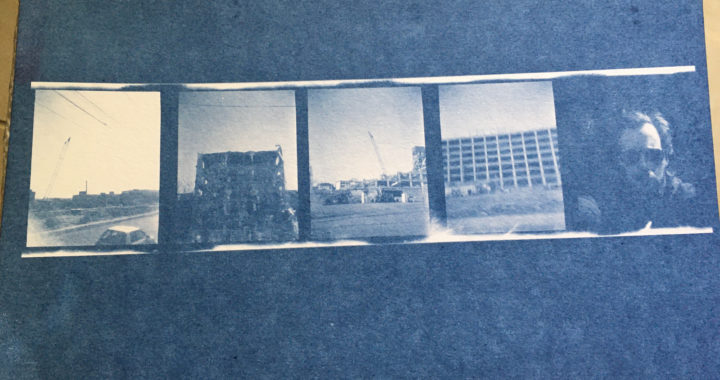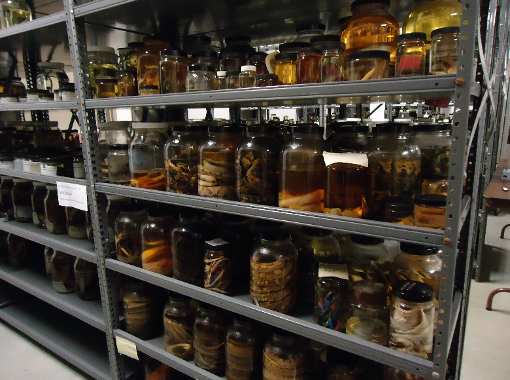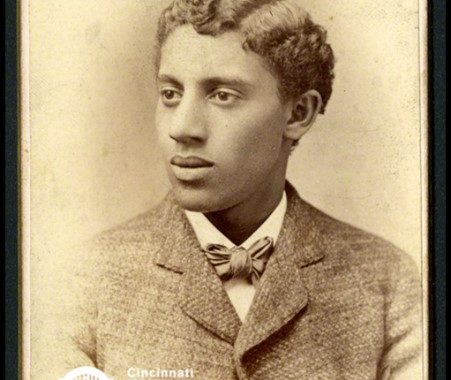These are strange times, indeed, what with much of the world on lockdown due to pandemic. However, time and events march on and there is perhaps cause to be optimistic for better times returning in the fall.
[READ MORE]Author Archive: Jessica Prater
Early Photography – Cyanotypes
The Photography Department of Cincinnati Museum Center holds about 1 million photographic prints, negatives, slides, glass plate negatives, and cased images such as daguerreotypes. This article is about early photography using examples from my personal collection.
[READ MORE]What’s in the jar?
The Zoology collections at Cincinnati Museum Center are divided into “fluid” and “dry” collections. The fluid collection space is one of my favorites at the museum – it is equal parts creepy and fascinating for most visitors. In the dry collections, specimens are typically skinned (removing all the organs and soft tissue), stuffed, and dried.
[READ MORE]Waltzing Matildasaurus!
OK, so there is no such thing as Matildasaurus, but there is a Muttaburrasaurus, an Early Cretaceous ornithopod dinosaur from northeastern Australia. Paleontology is not the world’s most lucrative profession, but it does have its advantages, often including the ability to travel for work. During this period of Covid-19 quarantine for so many of us, it seems like an opportune time to relive a paleo-adventure and share a little virtual travel Down Under.
[READ MORE]Zoology CSI
Zoology CSI By: Heather Farrington, Curator of Zoology Even at the dawn of the genetic age, it was known that only living (or once living) cells could be a source of DNA for study. Blood, tissues such as skin and muscle, and reproductive cells such as sperm were standard sources of genetic material. Structures such as fur, hair, feathers, shells, claws, and nails were thought to be made up only of secreted proteins, with no living cells, and therefore were of little value to geneticists unless there were still skin cells attached. If you’ve ever seen a TV crime drama, this is why hair samples are always collected by pulling rather than cutting, so that the skin cells at the base of the hair follicle (living cells containing DNA) are attached. After a cell dies, the DNA inside begins to degrade, or break down […]
[READ MORE]Adventures in Brazil’s Pantanal Region
Have you ever wondered what our curators do on vacation? Are we true nerds at heart and spend our vacations doing something related to our fields – visiting museums, libraries, archives, digging up fossils, exploring nature, or visiting historical and cultural sites?
[READ MORE]Be a citizen scientist with project NestWatch!
Looking for an activity to get you out of the house this summer, while maintaining proper social distancing? Want to learn more about the animals living around you? Consider participating in Project NestWatch!
[READ MORE]Early Photography – Part 4 of 4
The Photography Department of Cincinnati Museum Center holds about 1 million photographic prints, negatives, slides, glass plate negatives, and cased images such as daguerreotype. This article is about early photography using examples from our collection.
[READ MORE]The Spanish Flu
In the midst of the 1918 influenza pandemic, Cincinnati’s Mayor made the decision to give up. There was pressure from businesses, saloons, clergy and citizens to allow them to get back to normal daily life. How did the city get to this point and what happened before and after?
[READ MORE]From Roadkill to Museum Specimen
Below you will find a brief account of how we prepare bird skins for the museum collection. If you want to see this process in more graphic detail, we’ll provide some video links at the end.
[READ MORE]









